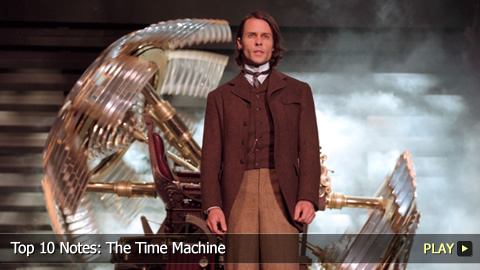Top 10 Notes: The Time Machine

#10 – About the Author
Born in 1866 in Kent, England, H.G. Wells became interested in reading after breaking his leg when he was 8. But when his father subsequently hurt his leg, Wells helped the family by working as an apprentice in diverse professions. He started writing his own material in the 1800s while studying science and teaching, and has since become known as one of the Fathers of Science Fiction.
#9 – Influences and Inspirations
It was while studying biology at the Normal School of Science that Wells wrote “The Chronic Argonauts.” That time travel story planted the seed for his 1895 science fiction novella “The Time Machine.” It’s with the very introduction of the time machine that Wells imagines a possible future for humankind. The negative spin he takes puts the tale in a literary subgenre known as Dying Earth.
#8 – Settings and Era
“The Time Machine” is set during the late-19th century, where the Time Traveller lived a mostly isolated existence. It also visits the communal living spaces of the Eloi and Morlocks in the year 802,701 AD. While London, England is the general location, the city technically doesn’t exist in the future as it did in the past. Thanks to his time machine, we also see him go 30 million years into a dire future.
#7 – Plot
After an unnamed narrator introduces the protagonist, the Time Traveller takes over to recount his journey to various futures using a time machine. When he arrives in 802,701 AD, he encounters two species: the Eloi and the Morlocks. After befriending an Eloi named Weena, the Traveller heads to earth’s bleak and unpromising future. He makes a return to the 19th century to warn his dinner guests about what he’s seen but then leaves again for good.
#6 – The Time Traveller
Though we’re never told his real name, we do know that The Time Traveller is a scientist and inventor living in Richmond. While he’s obviously intelligent, he’s also a bit of a prankster so his friends initially hesitate to believe in his time-traveling machine. He possesses scientific curiosity, which is clearly displayed when he encounters the Eloi and Morlocks, and in his desire to go further into the future after escaping.
#5 – Eloi
The Eloi are the first of two species the Time Traveller meets in the future. They’re beautiful and graceful adults that are like children when it comes to their lack of intelligence. They also eat fruits, wear clothes and represent what the Time Traveller theorizes the lazy, rich upper classes of the past have evolved into. However, an Eloi named Weena differentiates herself from the pack by showing appreciation and affection for the Traveler after he saves her from danger. Weena exhibits all the good and bad characteristics of this future race.
#4 – Morlocks
The Morlocks are the second species The Time Traveller meets in 802,701 AD. They hunt the Eloi for food, and possess traits that are in complete opposition to their prey. These hideous-looking nocturnal creatures also live under the earth. Despite all this, they do have some brains and are a laboring folk. The Time Traveller thus associates them with the previous societies’ lower classes.
#3 – Values and Themes
Wells lived in the 19th century, during an era of booming industry. This influenced his political views, which included a belief in change and progress for the less privileged social classes. His ideas on life are thus reflected in his depiction of the Eloi and Morlocks. These two species also raise questions about the concept of community. Other themes explored in the novella include science, time and technology.
#2 – Modern Popularity
First published in 1895, “The Time Machine” has since captured the imaginations of millions of readers by bringing the idea of time travel to mainstream consciousness. In fact, Wells is credited with creating the name of those vehicles that would be theoretically used to move people between different points in time.
#1 – Adaptations
While it has lent itself to radio, literary sequels and comic book adaptations, Wells’ tale has also been referenced on television and turned into movies. One of its most well known early film adaptations is George Pal’s Oscar-winning 1960 version. Wells’ great-grandson, Simon Wells, directed a more recent adaptation in 2002, which modified certain elements and received an Oscar nod for Best Makeup.
Do you agree with our list? What’s your favorite piece of “The Time Machine” trivia? Be sure to subscribe to WatchMojo.com for more entertaining top 10s.